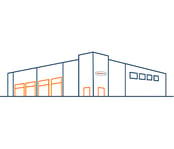How a Transportation Network Analysis can help you control costs and deliver you a competitive advantage to your supply chain.
Optimizing your warehousing and transportation network can be an overwhelming experience. Where do you start? A supply chain analysis can look at every angle to find improvements in moving your product or service to your customer. I helps to start asking yourself a few questions -
- Do you have the right procurement and sourcing strategy?
- Have you analyzed your transportation network and are you utilizing the most efficient modes and routes?
- Are your warehouses or distribution centers in the right locations based on the regions you serve?
- Is your warehouse layout optimized to your order volumes?
- Have you mapped your order to deliver process?
- Have you explored automation solutions in your supply chain?
The list can go on and on!
To help you get started, we'd like to share how a transportation network analysis can help you reimagine your supply chain, deliver service enhancements, and help control costs.
First, let's define a transportation network analysis.
A transportation network analysis takes a look at your current transportation processes and based on your growth, changing business landscape, and objectives, designs alternative scenarios to get your product to market in the most efficient and cost effective method.
Are you asking yourself these questions?
- Are you shipping LTL when you could be optimizing your orders into full truckload shipments?
- Can you consolidate orders with other shippers to further drive cost savings?
- Are you needing to increase your speed to market to compete with Amazon?
A transportation network analysis can help you find an ideal future state for your supply chain.
Here are a few quick tips as you get started:
1. It doesn't take much to get started
Leading supply chain management software systems perform key network analysis algorithms with just a few data points. With a solid understanding of current process flow and a few months of historical shipment data showing origin, destination, size, and weight, a network analysis may compare an existing supply chain network to an alternate one and highlight opportunities for improvement.
Logistics consultants and third party logistics providers (3PLs) can provide a formal network analysis with the right software. Llamasoft, JDA Software, and Logility are all leading supply chain management software systems, but what is important is finding the right partner that can leverage the tools and understand your needs. So be sure to find a provider that knows your industry and understands your business objectives, growth strategy, and obstacles.
Which brings us to our next point, how do I choose a company that can perform an analysis of my supply chain?
2. Build a strategic logistics partnership
There are multiple options to perform a transportation network analysis: Individual supply chain consultants, big corporations, third-party logistics providers, and small consulting companies. When selecting a partner, consider a company that can bring accountability to the forefront. Bottom line – results matter and the partnership must be built on trust.
But how do you evaluate a potential vendor to perform a network study?
- Accountability: Will your potential partner design and deliver your transportation network analysis? If your partner won't handle the implementation, be sure you understand how they will integrate with your logistics service provider throughout the execution. If you do partner with a 3PL to handle your transportation network analysis be sure they take an objective approach and understand your industry. Working with a single partner that can design and delivery your transportation network analysis can be a flexible solution to quickly pivot and make changes as your business scales.
- Industries experience: Supply chains can vary widely inside of an industry and even more between industries. Ask your potential partner what clients they have worked with in your industry and request specific examples of the value they have delivered through supply chain analysis studies.
- Available data and intellectual knowledge. The transfer of company operations and data is critical. Be sure to select a partner that can make quality assumptions in the absence of concrete data and processes.
3. Don't be overwhelmed by the level of detail
A preliminary study can indicate costs and opportunities associated with shipping your freight to each point within your network. A more in-depth study may segment the lane by price, customer, or even per-pound to provide the actual cost of doing business.
Ultimately, a network analysis study can identify inefficiencies and suggest optimal sourcing and shipment planning strategies. Studies can find that you may ship multiple orders to the same location several times a week, ship to different locations within miles of each other, or both. A smart use of the information from your analysis, in collaboration with the right adviser, can offer new solutions to optimize your freight, consolidate purchase orders, or implement a multi-stop method of shipping. Bottom line: be transparent with your partner.
A formal network analysis can prove to be beneficial in providing alternative scenarios to your supply chain that can control costs, bring better visibility, and help you operate more efficiently. If you're thinking about performing a formal transportation network analysis, find the right adviser that has experience in your industry, aligns to your business growth objectives, and can be a long-term strategic partner.











